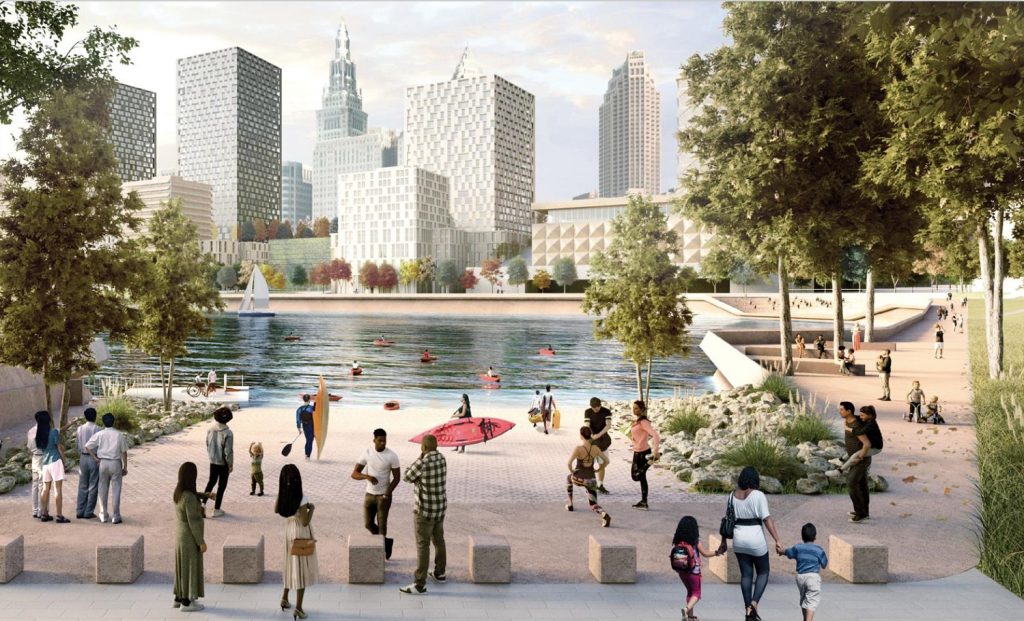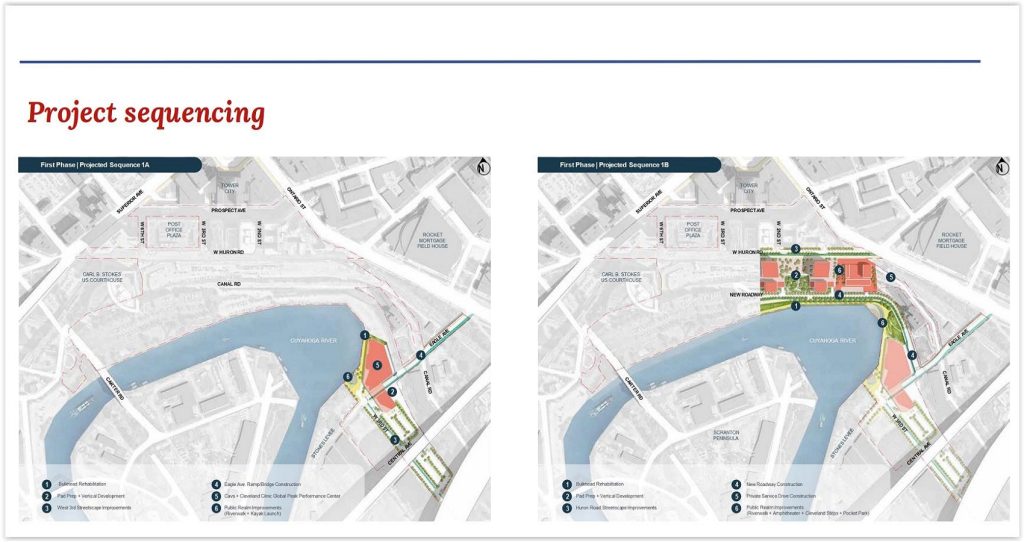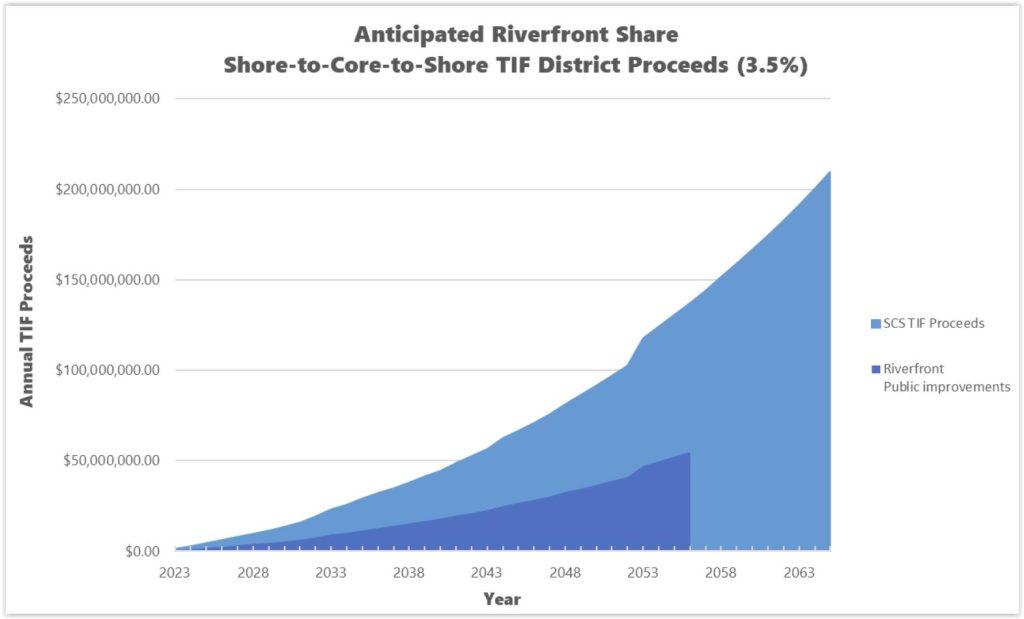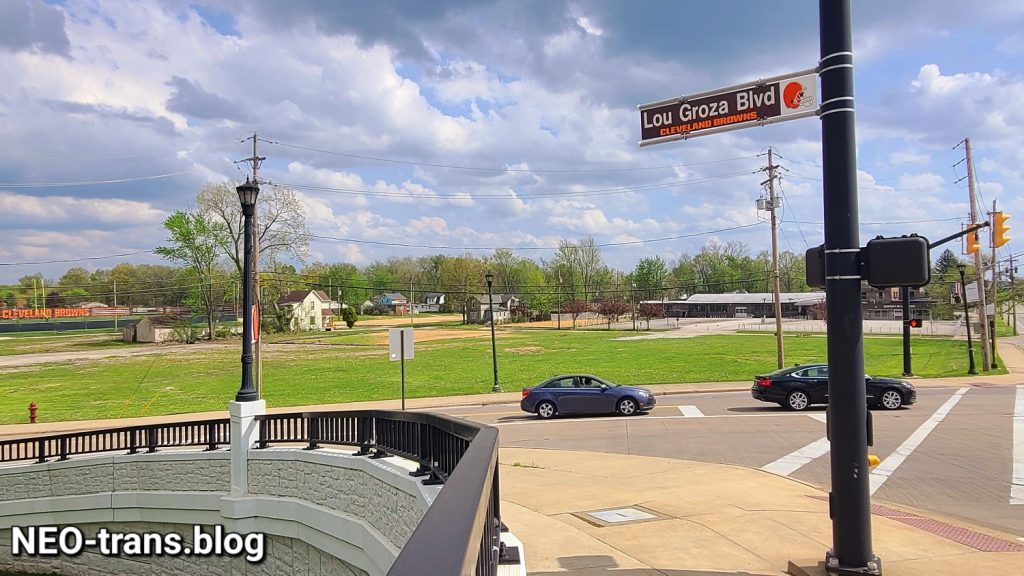
The Kayak Launch Plaza in Bedrock Real Estate’s riverfront development is just one of many pieces of public infrastructure features the city and the developer are working together to achieve. A tax-increment financing district is being set up to help much of that public infrastructure (Adjaye Associates). CLICK IMAGES TO ENLARGE THEM.
City TIF, Bedrock to build riverfront foundations
ARTICLE UPDATED JULY 29, 2024
City Planning Commission today voted unanimously to recommend that City Council approve a 45-year, project-specific tax-increment financing (TIF) deal with Bedrock Real Estate to generate $400 million for infrastructure to support Bedrock’s $3.5 billion riverfront development. This would create a second, albeit smaller TIF district downtown to support major waterfront and urban core improvements that could ultimately generate up to $1 billion in public funds for the riverfront.
The Bedrock project-based riverfront TIF would be pulled out of the city’s larger Shore-to-Core-to-Shore TIF District, passed by City Council in March. The reason is that a different state law applies to a project-based TIF versus a district-wide TIF and two TIFs cannot apply to the same property. City officials negotiated a community benefits agreement (CBA) with Detroit-based Bedrock associated with the TIF to help neighborhoods plus minority/disadvantaged businesses and workers.
Bedrock’s multi-phase riverfront development proposes more than 12 acres of public spaces along the Cuyahoga River, 2,000 new housing units, and more than one million square feet of office space, retail and entertainment. The city anticipates an economic impact of more than 30,000 new direct jobs and over $10 billion in new taxes generated by the riverfront development in the next 30 years.
The riverfront TIF will support public improvements including district parking, a riverside boardwalk, relocating roads, building bridges, constructing public parks and open spaces, plus utilities, site clean up and more, said Jessica Trivisonno, Cleveland Mayor Justin Bibb’s senior advisor for major projects. Any city bond issuances resulting from the Bedrock Project TIF will be subject to approval by City Council.
The TIF is proposed to begin in 2027, coinciding with the expected completion date of the 210,000-square-foot Cleveland Clinic Global Peak Performance Center in partnership with the Cleveland Cavaliers. Construction on that facility is due to start this fall but site preparations are already underway. The TIF is for 30 years with an option to extend it by another 15 years.

Properties shaded in blue are parcels that will be pulled out of the recently approved Shore-to-Core-to-Shore tax increment financing district and put into a proposed Bedrock riverfront project tax increment financing agreement. The parcels outlined with dashed lines are air-rights properties above the ground, including much of Tower City Center and its streets which are built on bridges above the track level of the former Cleveland Union Terminal railroad station (City of Cleveland).
“As projects are built, they will begin generating TIF revenue,” Trivisonno said at today’s planning commission meeting. “Only early projects TIFs will last the full 45 years. Based on current construction estimates, the average project TIF term will be 38 years. This is a non-school TIF, meaning no taxing entity will receive a penny less from property taxes than they do today due to the Bedrock Project TIF.”
Payments In Lieu Of Taxes (PILOTs) resulting from Bedrock’s vertical developments will be deposited into the Bedrock Project TIF. PILOTs from land value appreciation will still go to the Shore-to-Core-to-Shore TIF District as City Council approved in March, Trivisonno said.
The Shore-to-Core-to-Shore TIF District was expected to generate at least $3.3 billion over the next four decades. The Bedrock Project TIF would subtract from that an amount capped at $400 million. Another $75 million in anticipated riverfront infrastructure investments will be Bedrock’s responsibility. However, Trivisonno said additional state and federal grants will reduce the city’s TIF District contributions as well as Bedrock’s commitment.
That includes nearly $10 million worth of pre-TIF infrastructure work began a year ago for the Cleveland Clinic Global Peak Performance Center next to Collision Bend in the Cuyahoga River. That came from a mix of public and private sources. Another $10 million in state funds were pledged to the Bedrock riverfront development in the state of Ohio’s $4.2 billion capital budget.
The Bedrock Project TIF includes a comprehensive CBA that would require Bedrock to build approximately 400 residential units (or 20 percent of all projected units) at or below market-rate rents. Of that, 160 units will be available to households with incomes ranging from 30-60 percent of the area median income and 240 units available to households with incomes ranging from 60-120 percent of the area median income.
And, at least 5 percent of the housing units constructed in the Bedrock riverfront development must be dedicated as for-sale units. While a small number, that share of for-sale housing was a point of pride for city officials who said they want to see more for-sale housing built downtown, despite scaling back city incentives in the form of tax abatements on residential developments last year.
Bedrock is also to make a total of $25 million in neighborhood contributions at certain project milestones. That includes $15 million to a Neighborhood Investment Fund, $5 million in a Minority Business Credit Fund, $3 million in workforce development contributions, $1 million in city resident contributions plus $1 million for mentorship and training. Trivisonno said the CBA is a new model for managing projects for the city.
“It is our most aggressive and comprehensive CBA that we have to date,” she said. “This project and this initiative is a way for us to really get all of these benefits by still protecting the general fund.”
“Some of that money will be available in the next year or so to invest in city neighborhoods,” added Tyson Mitchell, director of Cleveland’s Office of Equal Opportunity.
Other CBA elements in the Bedrock Project TIF include commitments to small and minority businesses that were requested by the city, Mitchell added. Among them are awarding 40 percent of contracts to minority, female and Cleveland-based small businesses.
Twenty percent of the project workforce must be comprised of Cleveland residents and four percent of resident workforce hours must be worked by low-income persons, he said. And there must be mentor-protégé participation as well as reduced-rent or free retail spaces made available in the development to small businesses.
Planning Commission Vice Chair August Fluker said he wanted metrics to track and measure the outcomes of the CBA to see if it’s delivering its promises. He said that’s something the city has done a poor job at for a long time with other CBAs.
“Historically, in this city, all of my life, we have not done a great job of understanding the outcome of what success looks like, not just in numbers and checking boxes but also making sure that those outcomes are measurable and active.”
“We track the minority goals,” Mitchell responded. “We’re going to put these community benefits in our system and they will be tracked throughout the project with milestones and outcomes and we’ll be able to tell some good stories of success when we’re done.”
He noted that a specific component in the CBA involves hiring a “community benefit fellow” — a five-year project led by a staffperson to research opportunities within the project to be more equitable and build more wealth in the community.
END





